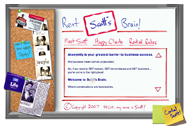
Since this is my final workweek of 2007, I’m going to post a ridiculously long list … every day. Be sure to check back all week!
And, don’t forget to read the other ridiculously long lists in the series:
101 Lessons Learned from 2007
101 Questions Every Marketer Must
But for now:
101 Ways to Create a Powerful Web Presence
1. Blog every single day.
2. Comment on other people’s blogs, especially when they link to your blog.
3. Post at least three videos on YouTube. Make them fun, cool, and most importantly – let the videos show you doing what you do. No more than three minutes each.
4. Post pictures on Flickr of you being yourself, working with clients, doing things you love, and most importantly – doing what you do.
5. Publish at least one article a month on public databases like www.ezinearticles.com. They get AWESOME Google rankings for ya.
6. Write and give away at least one free ebook a year.
7. Any time someone asks to reprint one of your articles, SAY YES!
8. Any time someone wants to interview you for her podcast, blog or newsletter, SAY YES!
9. Post your tour, schedule or travel calendar on your website.
10. Blog every single day.
11. Make use of social networking sites like MySpace, Facebook and LinkedIn. Just try not to get addicted. Accept friend requests from everyone.
12. Create a lens on Squidoo.
13. Publish a regular ezine. Share 1/2 of the main article in the body of your email letter and then publish the rest of it online to drive traffic.
14. Google your name, company name and tagline every week. It’s a great motivator to boost your web presence, especially if the only thing that comes up is your high school golf team score.
15. Publish your profile on ZoomInfo.
16. Post pictures of your customers using your products. Great testimonial.
17. Post videos of your customers using and talking about your products. Even better testimonial.
18. Don’t have (just) a website. Have several. Create an interconnected network of various sites that all point to your MAIN site. Think octopus, not earthworm. And think destination, not website.
19. Get yourself on Wikipedia. (This is REALLY hard to do, but it’s a great goal to shoot for.)
20. Blog every single day.
21. If you’re an author, make ebook versions of your books available for download. I say give ‘em away for free.
22. Include a Media Room on your website. This builds your credibility and expertise. Which will attract other media outlets to seek you out. Which will lead to more interviews. Which will lead to more hits on Google whenever someone types in your name or your area of expertise.
23. Interview other people and post the transcripts or audio files online. They’ll take ownership of the piece and tell everyone they know to come to your site.
24. Start an online TV network.
25. Just be remarkable.
26. Give more speeches. Even if they’re free. See, what happens is, the organization you speak for will include your name and bio on their website. They’ll also post the conference agenda as a PDF online, which will come up as a hit on Google when people type in your name or area of expertise. Sweet.
27. Figure out what everyone else in your industry is doing and then do the opposite.
28. Post lots of lists.
29. Blog every single day.
30. Post your PowerPoint slides on Slide Share or your blog. (NOTE: don’t do this if your slides SUCK. And most people’s slides suck.)
31. Capture emails and build your list. Create a permission asset. Emails are GOLD.
32. Register misspellings, permutations and variations of your main URL and redirect them to your homepage.
33. I don’t know much about Search Engine Optimization, Google Ad words and Pay-Per-Click, but I hear that stuff works pretty well. Something to think about.
34. Got a book? Cool. Get it on Google Book Search.
35. Speaking of Google, get lots of Google alerts on your name, company name, product name, etc. This will help you stay current with what’s being said about you on the Web. (And if nobody is talking about you on the web, you’re in trouble.)
36. Review books on Amazon.com.
37. Do surveys on your website and publish the results.
38. Do audio podcasts.
39. Do video podcasts.
40. Then post them on your blog.
41. (And of course, blog every single day.)
42. Google the names of the leaders in your industry. Evaluate their search results. Check out their web presence and see what they’re doing right. Then copy them.
43. If possible, get on CNN. That really helped me.
44. Join organizations, non-profits and trade associations. Get listed on their directories. Also, consider taking a leadership position or becoming a board member. They might even give you your own page on the organization’s website! (NOTE: don’t sign up just to get listed. Sign up to learn, grow, give back and make friends. Let web presence be incidental, not a intentional.)
45. FACE IT: you’re not giving away enough free stuff. Give more. The more you give away for free, the wealthier you will be. More on that theory here.
46. Share link love FIRST. People will be happy to reciprocate.
47. Send blog posts to people who would appreciate them. BUT, don’t ask them to blog about you. Just deliver value. Reach out to someone new. I did this once and the guy ended up blogging about me, which led to about 1 million hits in five days.
48. Learn about Digg and get dug. Unbelievably powerful.
49. Every time you meet someone who says, “Yeah, I’ve heard of you!” or “Oh, I’ve been to your site before,” write it down. Keep a Word of Mouth Journal. Notice patterns and soon you will hit a critical mass.
50. Dude: just be everywhere!
51. Leverage your expertise in every possible way.
52. Tell your story and make sure other people are telling it too.
53. Don’t cheap out on your website. It’s worth it.
54. Every time someone comes to your website, make sure they know THE ONE THING YOU WANT THEM TO DO, right away.
55. Blog every single day.
56. Blog every single day.
57. Blog every single day.
58. Blog every single day.
59. Blog every single day.
60. Blog every single day.
61. Blog every single day.
62. Blog every single day.
63. Blog every single day.
64. Blog every single day.
65. Blog every single day.
66. Blog every single day.
67. Blog every single day.
68. Blog every single day.
69. Blog every single day.
70. Blog every single day.
71. Blog every single day.
72. Blog every single day.
73. Blog every single day. (Any questions on this one?)
74. Install Google Analytics. Figure out where people are coming from.
75. Post in forums. Write intelligent, value-added responses. And have a cool signature.
76. Blog every single day.
77. Personally, I think press releases are WORTHLESS. However, many people have had great success with PR Web and other press release websites. Something to thing about.
78. Have some kind of lead-capturing device.
79. Submit your RSS feeds to Feed Burner.
80. Buy lots of domains and redirect them to your main site until you find another use for them.
81. Connect with other like-minded professionals who are ALSO creating a web presence. Have virtual lunches, regular email conversations and listserve discussions to brainstorm ideas and keep each other accountable.
82. SIX WORDS: Send This Site to a Friend!
83. Google the phrase “creating a web presence.” Read up.
84. Email [email protected] and ask me what the biggest marketing mistake made by entrepreneurs is. I’m happy to share it with you.
85. Figure out your Noticeable Number. Quantify the most remarkable aspect about your business and put a counter on your page that encourages word of mouth and revisitability. (Think McDonalds’ Billion Hamburger Counter).
86. Everything you write (articles, blog posts, press releases) MUST have a response mechanism built into it. Your writing becomes persuasive and effective the moment it compels the reader act upon (not think about) something. Here’s a mini-list of different types of response mechanisms to try:
o Go to this website, login if you’re a first time user…
o Email me with your three biggest questions about…
o Call me for your free consultation on…
o Send me a copy of your…
o Post your best story about…
o Link to this post on your blog, along with your list of…
o Leave a comment with your three best techniques for…
o I challenge you to try this for a week. Email me after you’ve…
o Try this on your blog and then send me the link…
o For a free downloadable ebook on this topic, go to…
o To receive my weekly ezine for tips on…
o Send an email with the words “I need sales!” in the subject line…
o If you’d like to know the rest of the formula, fax your letterhead to…
87. As you can see, I’m big on writing. And not just because I AM a writer. Mainly because writing is the basis of all wealth. Writing is the basis of all wealth. Writing is the basis of all wealth. Writing is the basis of all wealth. (GOT THAT?)
88. Speaking of writing: blog every single day.
89. And use Technorati to promote your blog.
90. Also, think about getting Meebo Messenger. Coolest thing on the Internet.
91. Contribute to entries on Wikipedia.
92. Start your own group on Facebook.
93. Use lots of colorful, singing, dancing pop ups on your website. (No, wait, sorry. Wrong list.)
94. Read Seth Godin’s blog. Do what he says.
95. Read Top Peters’ blog. Do what he says.
96. Read Bob Baker’s blog. Do what he says.
97. Evaluate your website’s hit and unique user ratio. Set a goal to double it within 12 months.
98. Evaluate your present newsletter, RSS feed or other type of subscriber number. Set a goal to double it within 12 months.
99. Just google “Gitomer.” Now THAT’S a web presence!
100. Read the book Naked Conversations. Totally awesome.
101. Read the book The Cluetrain Manifesto. Absolutely the best book ever written about the Internet.
LET ME ASK YA THIS…
How’s your web presence?
LET ME SUGGEST THIS…
Right here, right now, post your list: Top 10 Ways to Create a Powerful Web Presence. We’d love to see it!
* * * *
Scott Ginsberg
That Guy with the Nametag
 Consultants, schmonsultants.
Consultants, schmonsultants.
No systems. No formulas. Just someone who listens, asks KILLER questions and facilitates creative breakthroughs.
Rent Scott’s Brain today!

 During the late 1800’s, two inventors had almost identical ideas for this AMAZING new transmitting device called “The Telephone.”
During the late 1800’s, two inventors had almost identical ideas for this AMAZING new transmitting device called “The Telephone.” Consultants. Bah.
Consultants. Bah. Every have a bunch of random thoughts you need to get out of your brain and onto the page?
Every have a bunch of random thoughts you need to get out of your brain and onto the page? Coaching, schmoaching.
Coaching, schmoaching. People need permission.
People need permission. Wanna write a book?
Wanna write a book? Welcome back, Smithy!
Welcome back, Smithy! Wanna write a book?
Wanna write a book? As we approach the end of 2007, it’s important to ask yourself (and your team) Growth Questions.
As we approach the end of 2007, it’s important to ask yourself (and your team) Growth Questions.  Enjoy this post?
Enjoy this post? 15 to 30 billion.
15 to 30 billion.  Enjoy this post?
Enjoy this post? Are you a Wordsmith?
Are you a Wordsmith? Enjoy this post?
Enjoy this post?
 Enjoy this post?
Enjoy this post? Let’s talk about “tolerance.”
Let’s talk about “tolerance.” Enjoy this post?
Enjoy this post?